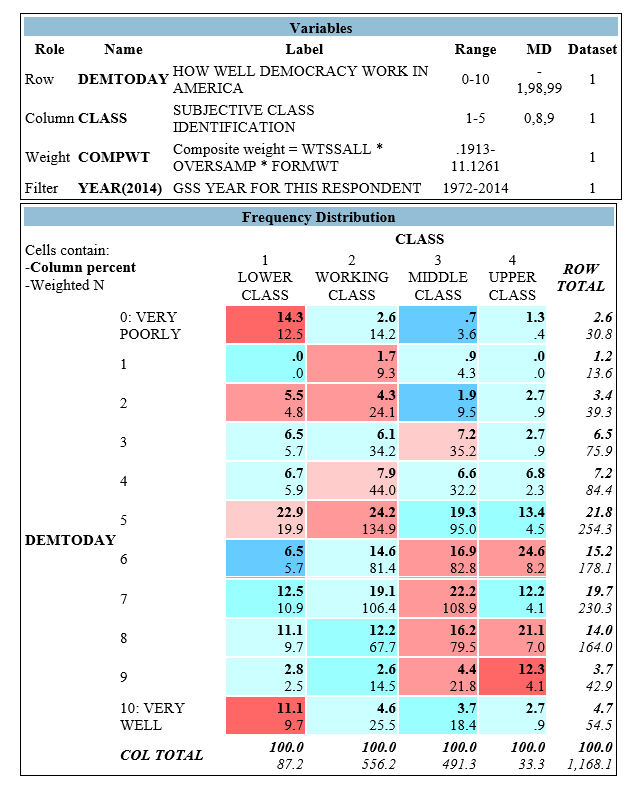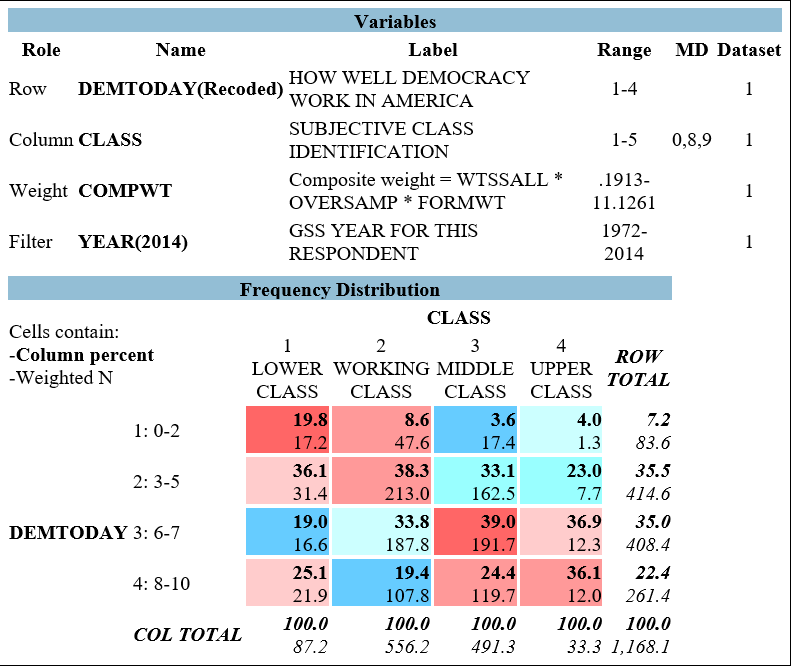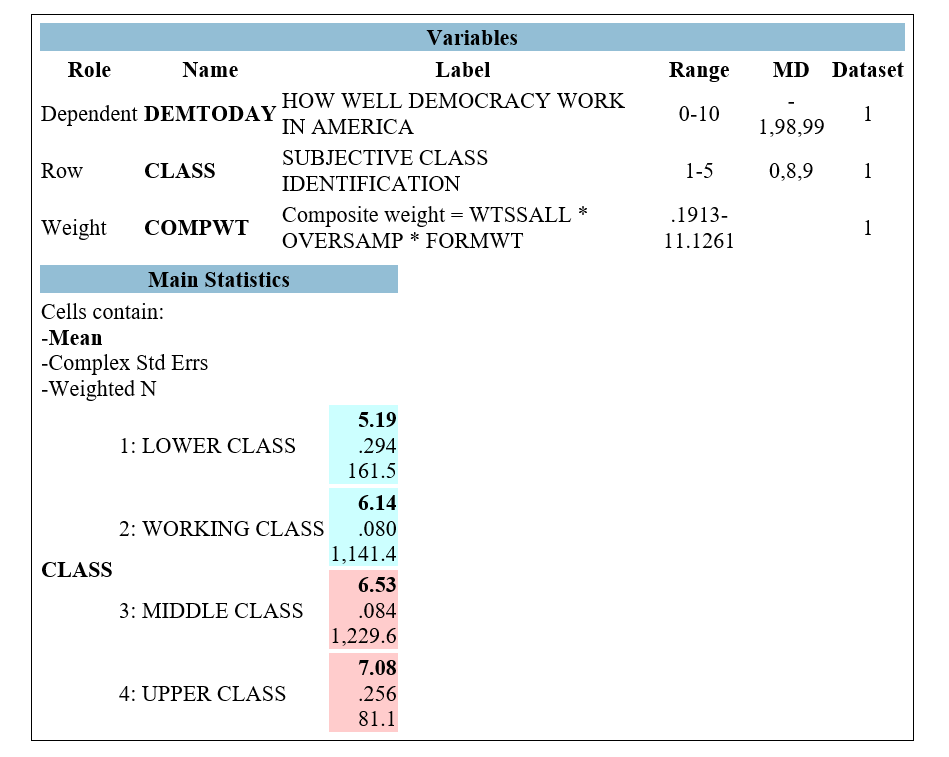Deck 5: Analyzing Class With the GSS
سؤال
سؤال
سؤال
سؤال
سؤال
سؤال
سؤال
سؤال
سؤال
سؤال

فتح الحزمة
قم بالتسجيل لفتح البطاقات في هذه المجموعة!
Unlock Deck
Unlock Deck
1/10
العب
ملء الشاشة (f)
Deck 5: Analyzing Class With the GSS
1
A researcher is interested to know whether people of different class backgrounds tend to hold different ideas about democracy. He creates Figure 5.1, where CLASS is a variable that indicates respondents' sense of themselves as lower-class, working-class, middle-class, or upper-class. DEMTODAY is a variable corresponding to the question "On the whole, on a scale of 0 to 10 where 0 is very poorly and 10 is very well. How well does democracy work in America today?"
Figure 5.1

-The variable CLASS is best described as:
A) dummy variable
B) nominal level
C) ordinal level
D) interval-ratio level
Figure 5.1

-The variable CLASS is best described as:
A) dummy variable
B) nominal level
C) ordinal level
D) interval-ratio level
C
2
A researcher is interested to know whether people of different class backgrounds tend to hold different ideas about democracy. He creates Figure 5.1, where CLASS is a variable that indicates respondents' sense of themselves as lower-class, working-class, middle-class, or upper-class. DEMTODAY is a variable corresponding to the question "On the whole, on a scale of 0 to 10 where 0 is very poorly and 10 is very well. How well does democracy work in America today?"
Figure 5.1

-The variable CLASS is best understood as:
A) a measure of respondents' family income
B) a measure of respondents' socio-economic status
C) a measure of respondents' wealth
D) a measure of respondents' class-based identity
Figure 5.1

-The variable CLASS is best understood as:
A) a measure of respondents' family income
B) a measure of respondents' socio-economic status
C) a measure of respondents' wealth
D) a measure of respondents' class-based identity
D
3
A researcher is interested to know whether people of different class backgrounds tend to hold different ideas about democracy. He creates Figure 5.1, where CLASS is a variable that indicates respondents' sense of themselves as lower-class, working-class, middle-class, or upper-class. DEMTODAY is a variable corresponding to the question "On the whole, on a scale of 0 to 10 where 0 is very poorly and 10 is very well. How well does democracy work in America today?"
Figure 5.1

-According to Figure 5.1, which group was most likely to respond that democracy is working "very poorly" in American today?
A) lower-class respondents
B) working-class respondents
C) middle-class respondents
D) upper-class respondents.
Figure 5.1

-According to Figure 5.1, which group was most likely to respond that democracy is working "very poorly" in American today?
A) lower-class respondents
B) working-class respondents
C) middle-class respondents
D) upper-class respondents.
A
4
A researcher is interested to know whether people of different class backgrounds tend to hold different ideas about democracy. He creates Figure 5.1, where CLASS is a variable that indicates respondents' sense of themselves as lower-class, working-class, middle-class, or upper-class. DEMTODAY is a variable corresponding to the question "On the whole, on a scale of 0 to 10 where 0 is very poorly and 10 is very well. How well does democracy work in America today?"
Figure 5.1

-Excluding the nonvalid response categories the variable DEMTODAY has _____ valid response categories.
A) 9
B) 10
C) 11
D) 12
Figure 5.1

-Excluding the nonvalid response categories the variable DEMTODAY has _____ valid response categories.
A) 9
B) 10
C) 11
D) 12

فتح الحزمة
افتح القفل للوصول البطاقات البالغ عددها 10 في هذه المجموعة.
فتح الحزمة
k this deck
5
A researcher is interested to know whether people of different class backgrounds tend to hold different ideas about democracy. He creates Figure 5.1, where CLASS is a variable that indicates respondents' sense of themselves as lower-class, working-class, middle-class, or upper-class. DEMTODAY is a variable corresponding to the question "On the whole, on a scale of 0 to 10 where 0 is very poorly and 10 is very well. How well does democracy work in America today?"
Figure 5.1

-According to Figure 5.1, which group was most likely to respond that democracy is working "very well" in American today?
A) lower-class respondents
B) working-class respondents
C) middle-class respondents
D) upper-class respondents.
Figure 5.1

-According to Figure 5.1, which group was most likely to respond that democracy is working "very well" in American today?
A) lower-class respondents
B) working-class respondents
C) middle-class respondents
D) upper-class respondents.

فتح الحزمة
افتح القفل للوصول البطاقات البالغ عددها 10 في هذه المجموعة.
فتح الحزمة
k this deck
6
A researcher is interested to know whether people of different class backgrounds tend to hold different ideas about democracy. He creates Figure 5.2, where CLASS is a variable that indicates respondents' sense of themselves as lower-class, working-class, middle-class, or upper-class. DEMTODAY is a variable corresponding to the question "On the whole, on a scale of 0 to 10 where 0 is very poorly and 10 is very well. How well does democracy work in America today?" The researcher re-coded DEMTODAY with the command "DEMTODAY (R: 0-2; 3-5; 6-7; 8-10)."
Figure 5.2

-When the variable DEMTODAY is recoded with the command "DEMTODAY (R: 0-2; 3-5; 6-7; 8-10)" what is the best way to indicate what a score of 4 represents?
A) The respondent believes that democracy in America is working very well.
B) The respondent believes that democracy in America is working moderately well.
C) The respondent believes that democracy in America is not working well.
D) The respondent believes that democracy in America is not working at all.
Figure 5.2

-When the variable DEMTODAY is recoded with the command "DEMTODAY (R: 0-2; 3-5; 6-7; 8-10)" what is the best way to indicate what a score of 4 represents?
A) The respondent believes that democracy in America is working very well.
B) The respondent believes that democracy in America is working moderately well.
C) The respondent believes that democracy in America is not working well.
D) The respondent believes that democracy in America is not working at all.

فتح الحزمة
افتح القفل للوصول البطاقات البالغ عددها 10 في هذه المجموعة.
فتح الحزمة
k this deck
7
A researcher is interested to know whether people of different class backgrounds tend to hold different ideas about democracy. He creates Figure 5.2, where CLASS is a variable that indicates respondents' sense of themselves as lower-class, working-class, middle-class, or upper-class. DEMTODAY is a variable corresponding to the question "On the whole, on a scale of 0 to 10 where 0 is very poorly and 10 is very well. How well does democracy work in America today?" The researcher re-coded DEMTODAY with the command "DEMTODAY (R: 0-2; 3-5; 6-7; 8-10)."
Figure 5.2

-Which of the following statements best describes the meaning of the 19.8, in the upper-left corner of Figure 5.2?
A) Of all the respondents surveyed, 19.8 % of respondents identified as lower-class and believed that democracy in America is not working well at all.
B) Of the respondents who believed that democracy in America is not working at all, 19.8% described themselves as being from the lower-class.
C) Of those respondents described themselves as lower-class, 19.8 believed that democracy in America is not working at all.
D) About 20 people surveyed identified as lower-class and believed that democracy in America is not working well at all.
Figure 5.2

-Which of the following statements best describes the meaning of the 19.8, in the upper-left corner of Figure 5.2?
A) Of all the respondents surveyed, 19.8 % of respondents identified as lower-class and believed that democracy in America is not working well at all.
B) Of the respondents who believed that democracy in America is not working at all, 19.8% described themselves as being from the lower-class.
C) Of those respondents described themselves as lower-class, 19.8 believed that democracy in America is not working at all.
D) About 20 people surveyed identified as lower-class and believed that democracy in America is not working well at all.

فتح الحزمة
افتح القفل للوصول البطاقات البالغ عددها 10 في هذه المجموعة.
فتح الحزمة
k this deck
8
A researcher is interested to know whether people of different class backgrounds tend to hold different ideas about democracy. He creates Figure 5.2, where CLASS is a variable that indicates respondents' sense of themselves as lower-class, working-class, middle-class, or upper-class. DEMTODAY is a variable corresponding to the question "On the whole, on a scale of 0 to 10 where 0 is very poorly and 10 is very well. How well does democracy work in America today?" The researcher re-coded DEMTODAY with the command "DEMTODAY (R: 0-2; 3-5; 6-7; 8-10)."
Figure 5.2

-Which of the following statements best describes the relationship between CLASS and DEMTODAY, as represented in Figure 5.2?
A) In general, there is a negative relationship between CLASS and DEMTODAY.
B) In general, as respondents' class increases, they are more likely to believe that democracy in America is working very well.
C) Regardless of respondents' class, most respondents believe that democracy in America is not working at all.
D) In general, as respondents' class increases, the likelihood of their believing that democracy in America is not working well at all also increases.
Figure 5.2

-Which of the following statements best describes the relationship between CLASS and DEMTODAY, as represented in Figure 5.2?
A) In general, there is a negative relationship between CLASS and DEMTODAY.
B) In general, as respondents' class increases, they are more likely to believe that democracy in America is working very well.
C) Regardless of respondents' class, most respondents believe that democracy in America is not working at all.
D) In general, as respondents' class increases, the likelihood of their believing that democracy in America is not working well at all also increases.

فتح الحزمة
افتح القفل للوصول البطاقات البالغ عددها 10 في هذه المجموعة.
فتح الحزمة
k this deck
9
Figure 5.3

-What is the best interpretation of the top number in the resulting table of "Main Statistics" (5.19)?
A) 5.19% of respondents identified as lower class.
B) Among respondents who identified as lower class, 5.19% believed that democracy is not working well in American today.
C) Among respondents who identified as lower class, the mean score on the variable DEMTODAY was 5.19
D) The likelihood of believing that democracy is not working well in American today is 5.19 times higher lower-class respondents, compared to upper-class respondents.

-What is the best interpretation of the top number in the resulting table of "Main Statistics" (5.19)?
A) 5.19% of respondents identified as lower class.
B) Among respondents who identified as lower class, 5.19% believed that democracy is not working well in American today.
C) Among respondents who identified as lower class, the mean score on the variable DEMTODAY was 5.19
D) The likelihood of believing that democracy is not working well in American today is 5.19 times higher lower-class respondents, compared to upper-class respondents.

فتح الحزمة
افتح القفل للوصول البطاقات البالغ عددها 10 في هذه المجموعة.
فتح الحزمة
k this deck
10
Figure 5.3

-More generally, Figure 5.3 suggests that:
A) As respondents' subjective class status increases, they are more likely to hold more negative views about how well democracy in America is working today.
B) On average, compared with respondents who described themselves as working- or lower-class, those who describe themselves as middle- or upper-class tend to believe that democracy in America is working better.
C) Regardless of social class, less than 10% of respondents believed that democracy in America is working well
D) Regardless of social class, fewer than 10% of respondents answered the survey question about how well democracy in American is working.

-More generally, Figure 5.3 suggests that:
A) As respondents' subjective class status increases, they are more likely to hold more negative views about how well democracy in America is working today.
B) On average, compared with respondents who described themselves as working- or lower-class, those who describe themselves as middle- or upper-class tend to believe that democracy in America is working better.
C) Regardless of social class, less than 10% of respondents believed that democracy in America is working well
D) Regardless of social class, fewer than 10% of respondents answered the survey question about how well democracy in American is working.

فتح الحزمة
افتح القفل للوصول البطاقات البالغ عددها 10 في هذه المجموعة.
فتح الحزمة
k this deck








